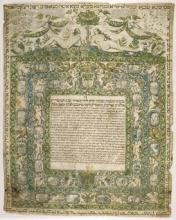Many people would assume that a legal document outlining the conditions for marriage and provisions for the potential end of a marriage is a modern invention of today's lawyer-saturated society. The truth is that the marriage contract, today known as the prenuptial agreement, is practically as old as marriage itself. It may not seem very romantic, but many societies of law have been in the practice of using marriage contracts, as well as revising them, for thousands of years. In Jewish culture, this contract is called a Ketubah.
The Ketubah is one of many inventions of the rabbinic age, the transition of Judaism from a priest-centered religion of sacrifice to an education-oriented religion of community and study. Approximately 2000 years ago when Judea was under the purview of the Roman Empire, there was a social movement that favored teachers called rabbis (Ravim) as ritual leaders, likely as a result of the sacred literature scribed, studied and commented on when Jews were living under captivity in Babylon. This new concept of faith revolved around debate and reform.
One of the reforms to come out of this period was the abolition of the Mohar, a sort of reverse dowry prescribed in ancient tradition. A Mohar was an agreed upon price a man paid to a woman or her family in exchange for her hand in marriage. The purpose of this price tag on nuptials was as a protection of the would-be bride. Should her husband die or divorce her, she may have been left with no way to support herself. The Mohar was an insurance policy on the marriage.
The problem, of course, was that most people married prior to accumulating enough resource to afford a Mohar. This placed an extra burden (as well as authority) on third parties such as the groom's parents where marriage was concerned. The Ketubah is a solution to that problem. Instead of requiring a Mohar up front, it is a contract that details terms for the marriage and exact recourse should it end prior to the bride's death. This contract allows two people to come to an agreement without outside interference and it also makes sure that poverty does not stand in the way of love and propriety.
Modern Jews still use Ketubot, though they are naturally not legally binding in terms of state law. Many couples see the Ketubah as a symbol of commitment, not a cold legal document. While it was designed to address cold, hard facts of finance, the Ketubah has become a reminder of more abstract duties two people have to one another in a marriage. At its best, it is a sign of gender equality, honesty and self-control in a romantic pairing.
Other religious traditions have similar marriage contracts. The Muslim Nikah is functionally identical to the Ketubah, while at various times in history (including the modern Covenant Marriage movement) there have been Christian marriage contracts as well. Another ancient faith, Zoroastrianism, requires a contract that has language much like the Nikah.
